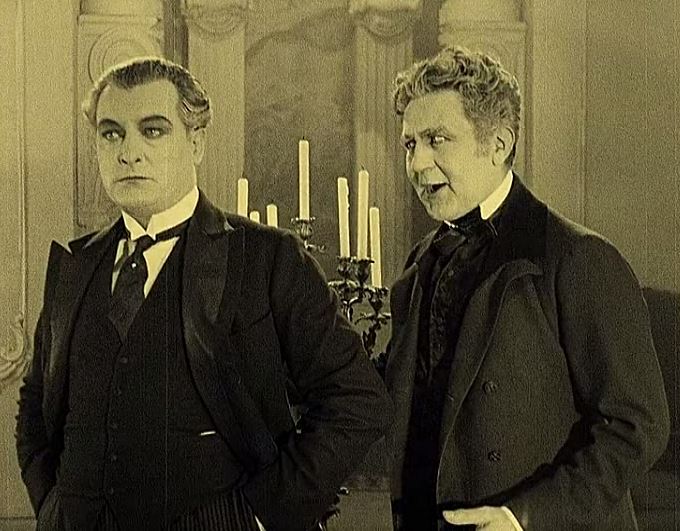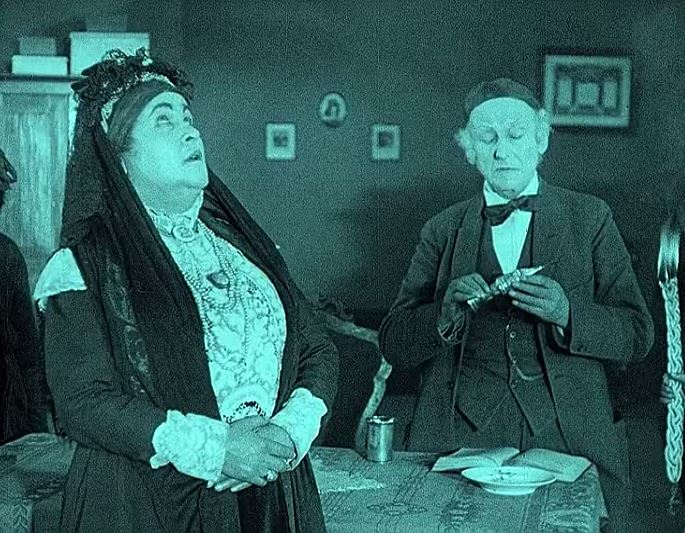

In Austria the Christian Social Party comes to power and the new chancellor, Dr. Schwerdtfeger, a fanatical anti-Semite, sees his people as being ruled by the Jews. He therefore passes a law through the National Assembly forcing all Jews to emigrate by the end of the year. The law is enthusiastically received by the non-Jewish population and the Jews leave the country. But after a short time a sober reality makes itself felt: cultural life becomes impoverished. In the theatres, only plays by Ludwig Ganghofer and Ludwig Anzengruber are still performed. Many cafes are empty or are converted into beer halls selling sausages. After an initial upturn, the economy declines, as business has greatly diminished, and has moved to other cities, such as Prague and Budapest. Inflation and unemployment run wild. Towards the end of the film, the National Assembly resolves to bring the Jews back again. However, to achieve the necessary two-thirds majority, Lotte and Leo, who have already illegally returned to Austria with forged papers identifying Leo as a French painter, have to remove the anti-Semitic parliamentary representative Bernard.
In the black and white footage of this silent film, Austrian Jews are harassed in the public market, physically menaced by thugs in the street, and forced en masse from the country, on foot or by train. Orthodox men, distinguished by their prayer shawls, payot, and traditional dress, carry Torah scrolls. The expulsion of Jews rips mixed-faith families in two. Familiar though this story may seem, these scenes are not taken from history: they come from a long-lost film that predates the Nazi period by a decade, Die Stadt Ohne Juden. Released in 1924, it was adapted from a satirical novel by Hugo Bettauer, an Austrian Jewish writer and journalist. At a time when Hitler was still a marginal figure, Bettauer was a vocal proponent of liberal views, including tolerance of homosexuals, education for women, and reduced punishments for those who received abortions — and, of course, the condemnation of anti-Semitism. The film portrayed the targeting of Austria’s Jews as a dystopian future.The expressionist scene featuring Hans Moser in the role of a ruthless anti-Semite is now available in its entirety for the first time. All in all, the political message of the film and the depiction of murderous anti-Semitism in Vienna in the 1920s are now significantly more sharply articulated.The movie also represents a stirring counterpoint to Austria’s historical connection to Nazism and anti-Semitic propaganda. Already in the 19th century, Austria was the center of politcal anti-Semitism. Hitler got his inspiration in Vienna. The City Without Jews opened in 1924 at all five of Vienna’s major movie theaters to enormous demand. As is now clear from the complete ending, which concludes with Austria acknowledging its wrongs and inviting the Jews back home for a joyful reunion of lovers and families, the film was quite overt in its message. Ironically, what was essentially a dystopian film concluded on a happier note than the actual history. Bettauer became the target of a virulent hate campaign, and was ultimately murdered by a Nazi named Otto Rothstock.
Im historischen Wien der 1920er Jahre, im Film als Utopia bezeichnet, herrschen in der Bevölkerung die drei epochalen Grunderfahrungen vor: Verlustgefühl, drohende soziale Deklassierung und eine Stimmung zwischen Revolutionsgeist und Erregungskultur. Zudem spitzen Inflation und Arbeitslosigkeit die gespannte Lage zu. Das Volk fordert die Ausweisung der Juden, die es für die negativen Entwicklungen verantwortlich macht. Der Bundeskanzler „Dr. Schwerdtfeger“, zunächst reserviert, setzt sich aus taktischen Gründen an die ideologische Spitze dieser Bewegung und liefert in seinen Reden vor dem Parlament Gründe der Unmöglichkeit des Zusammenlebens mit der jüdischen Bevölkerung. Hierzu werden verschiedene Stereotype aufgegriffen, die mit antisemitischer Rhetorik im Allgemeinen sowie bestimmter Stilmittel aus den Reden jener Zeit beinahe vollständig übereinstimmen. Die Ausweisung der Juden mit dem Zug bzw. als Fußmarsch wird detailliert vorgeführt. Die jüdischen Lebenswelten werden nebeneinander gezeigt und nicht nur, wie beispielsweise im Golem, als jüdische und christliche Bereiche. Sondern es wird verstärkt innerhalb der jüdischen Gemeinschaft in die „akkultierten“ Wiener Juden und die neu zugezogenen Ostjuden unterteilt, zwischen denen es so gut wie keine Verbindungen gibt. Alle Gesellschaftsteile werden klischeehaft dargestellt, was absichtlich inszeniert und bewusst eingesetzt wurde. Die meisten Figuren bewegen sich im städtisch-bürgerlichen Milieu bzw. in der Oberschicht. Die Juden aus dem Osten werden in ärmlichen Verhältnissen und in Beziehung zu religiöser Symbolik eingeführt. Sie reagieren auf die Ausweisung vornehmlich leidend und duldend.[ Nach dem erhofften wirtschaftlichen Aufschwung tritt sehr bald der kulturelle und wirtschaftliche Verfall ein. Wien „verdorft“.
»Die Stadt ohne Juden« betitelte Hugo Bettauer 1922 seinen Roman, der die damals noch utopische Vorstellung einer Vertreibung der Juden aus Wien beschrieb. Nur zwei Jahre später kam die Verfilmung in die Kinos. Im Film wurde der brisante Stoff abgeschwächt, konkrete realpolitische Bezüge vermieden: In der sagenhaften Republik Utopia, Adresse: Ballhausplatz in Wien, herrscht Unruhe. Die Arbeiter gehen auf die Straße, das Geld ist nichts mehr wert, Spekulanten befeuern mit ihrer Habsucht die Inflation. In den Wirtshäusern kennen die Menschen schon die Lösung: Hinaus mit den Juden. Die überspitzte politische Botschaft wurde verstanden. 14 Jahre nach der Filmpremiere wurde DIE STADT OHNE JUDEN von der grausigen Wirklichkeit eingeholt. Der Film gilt heute weltweit als erstes explizites filmkünstlerisches Statement gegen den Antisemitismus.
DVD-R has German intertitles with switchable English subtitles. Approx. 87 min. See film sample for audio and video quality!




